People take action to protect the marine environment
Society – Economy - Ngày đăng : 08:54, 04/10/2024
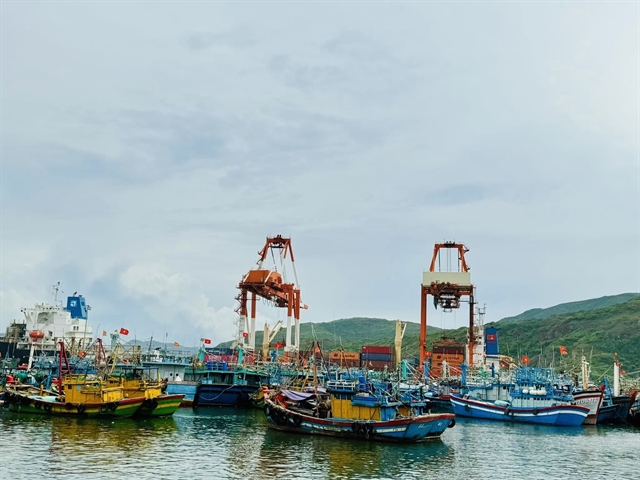 |
| Green and clean Quy Nhơn Fishing Port. — VNS Photo Thu Trang |
Thu Trang
BÌNH ĐỊNH — Captain Phan Thanh Trưởng and his 12 crew members no longer dispose of plastic waste in the sea.
Previously, during their 20-day shifts at sea, they used to throw their waste -- mostly plastic bottles and instant noodle packaging -- over the side of their boat.
Now, thanks to a new programme called 'Fishing Boats Bringing Plastic Waste Back to Shore', they have learned how to use net bags for collecting and containing trash.
“We realise that it is our responsibility, especially as marine citizens,” said Trưởng.
Trưởng, 52, is the captain of the BĐ91052 fishing vessel in Quy Nhơn City in the south-central province of Bình Định. He has worked as a fisherman for over 30 years.
“As captain, my role is very important. I always remind my colleagues during our journey not to throw waste away. To protect the ocean, we must ensure all trash is brought back to shore,” said Trưởng.
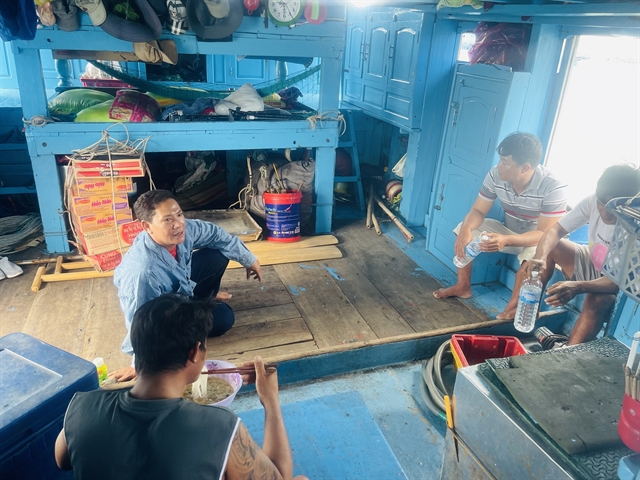 |
| Phan Thanh Trưởng (centre) instructs his seamen to put plastic waste in the right place for sorting after the ship docks. — VNS Photo Thu Trang |
Trưởng, along with many other fishermen in the city, has signed a commitment to safeguard the marine environment.
“We are fully aware of the issue and are determined to take action to keep our sea clean,” he said.
"After taking the plastic and packaging back to the shore, we will notify the collection team, who then transport these plastics and recyclables to a warehouse at the Quy Nhơn Fishing Port for sorting and recycling."
Preserve our sea
Trưởng is one of thousands of participants in the 'Fishing Boats Bringing Plastic Waste Back to Shore' programme at Quy Nhơn Port that was launched last year.
The programme has involved over 1,200 fishermen from 200 boats, and has so far collected nearly two tonnes of plastic and other recyclable materials, significantly contributing to the national and provincial goals of reducing marine litter.
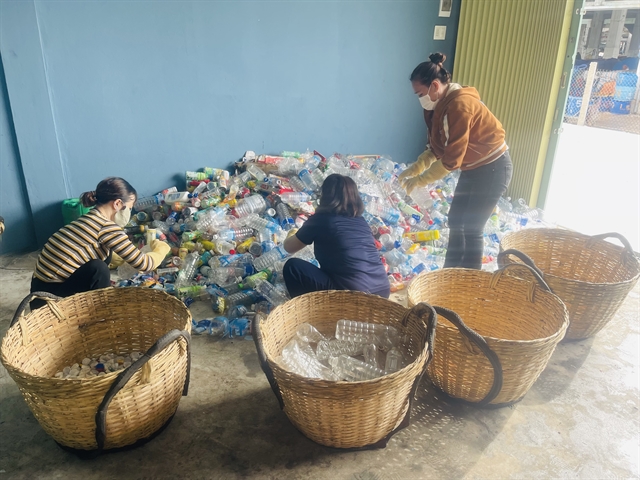 |
| People sort out plastic waste at the collection point in the Quy Nhơn Fishing Port. — VNS Photo Thu Trang |
The programme has been endorsed by the Bình Định Department of Agriculture and Rural Development, and serves as an example for preventing marine litter, ready to be replicated nationwide. To back this model, the Bình Định Department of Agriculture and Rural Development has issued a regulation requiring all fishing boats 15 metres or longer bring plastic waste back to shore.
The programme is under the three-year project ‘Scaling-up Integrated and Inclusive Waste Management Models through Empowering the Informal Sector and Fostering the Circular Economy’. It is funded by the Norwegian Government through the United Nations Development Programme (UNDP).
Green and clean city
Quy Nhơn is the hub of socio-economic development in Bình Định Province, attracting many investors and tourists.
At the Southeast Asia Tourism Forum 2020, Quy Nhơn was given the ASEAN Clean Tourist City Award for the first time, an award that it continues to win.
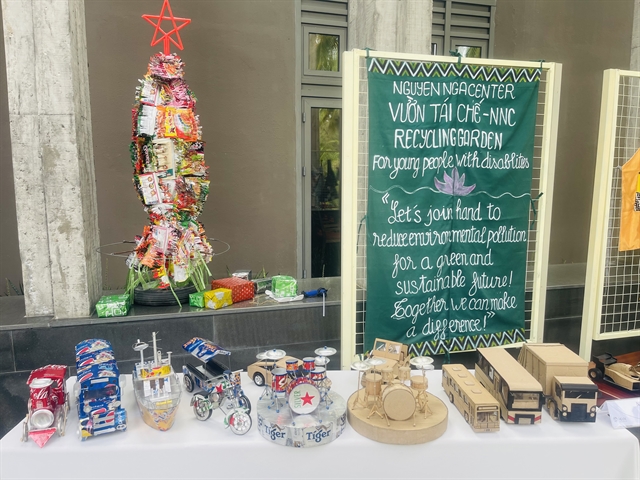 |
| Decorations made from waste by people with disabilities displayed in a recycle festival in Quy Nhơn City. — VNS Photo Thu Trang |
The Quy Nhơn City project aims to develop regulations, action plans and measures for waste management, replicate successful models, increase income for informal waste workers by 15-20 per cent, and encourage the greater participation of women workers.
Ramla Khalidi, UNDP Việt Nam Resident Representative, said that in 2022 UNDP and Bình Định Province signed a memorandum of understanding committing to strengthened collaboration on the circular economy, ocean economy, climate change, biodiversity, mine action, and sustainable rural development.
“The waste sorting at source programme represents significant progress in our journey towards sustainable waste management and our shared vision of a more sustainable future for Quy Nhơn City and Bình Định Province,” she said.
Ramla hopes to expand the ‘Fishing Boats Bringing Plastic Wastes Back to Shore’ to other fishing ports, and to integrate the informal sector into the province’s waste management programme.
“Think global and act local. The positive impact of these initiatives is evident at the local level, and it's important to remember that they are fully aligned with, and directly contribute to both national and provincial targets, especially the National Action Plan on Marine Litter Management, the Law on Environment Protection and Bình Định Provincial regulations,” she said.
Mette Moglestue, Deputy Head of Mission from the Norwegian Embassy in Việt Nam, said: “Sorting waste at source is crucial for both waste management and recycling. It is the foundation for any systematic intervention along the waste value chain. Innovation is certainly essential for smarter, better and more effective waste management.”
“Digital applications and technological transfer, innovative ideas and start-ups. These are just a few among many things that can potentially influence the development of waste management and the circular economy in Việt Nam,” she said.
Mette confirmed that the activities were important not only for the sustainable and inclusive socio-economic development of Quy Nhơn City, but demonstrated good models for other places to replicate or scale up.
Norway gives a high priority to preventing and mitigating plastic waste and pollution, and also plays a leading role in the global effort to promote clean and healthy oceans.
Marine plastic waste management
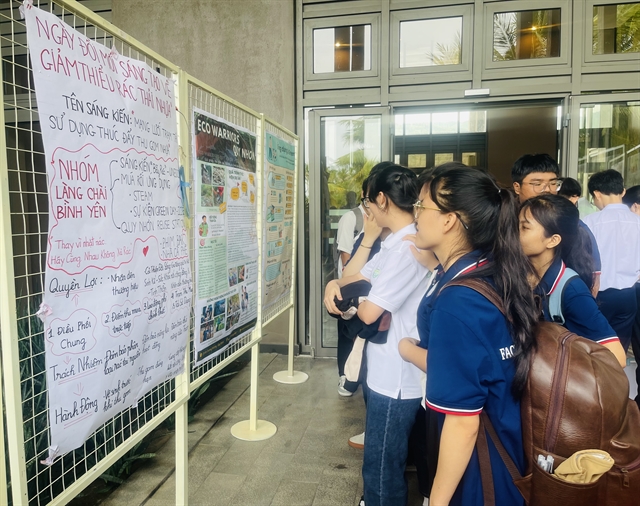 |
| Youth read posters about waste reuse and recycle in a festival held in Ghềnh Ráng Ward, Quy Nhơn City. — VNS Photo Thu Trang |
Hồ Đắc Chương, Deputy Director of the Bình Định Department of Agriculture and Rural Development, stated that reducing ocean plastic waste in fisheries, advancing circular economy practices, and raising awareness among fishing communities and enterprises are key goals for Bình Định Province.
“We hope that by next year, at least 70 percent of fishing ports will carry out the collection and sorting of domestic plastic waste generated from fishing vessels, and deliver it to functional units for processing. And the rate will reach 100 per cent by 2030,” said Chương.
A database on ocean plastic waste from fishing vessels will be built soon.
“The department has educated officials, workers, fishermen and traders in the port area on plastic waste management through loudspeakers, billboards and leaflets,” he said.
Collection points are arranged at the fishing port to ensure the collection of plastic waste brought back to shore by fishing vessels when docking at the port.
Fishing vessel waste collection teams are established based on the fishing port's environmental sanitation staff.
“The department’s experts give guidance for ship owners and captains to declare types of drinking water bottles, daily food and packaging used on fishing vessels when fishing vessels complete procedures to leave the port for fishing activities,” said Chương.
Results of waste collection from fishing vessels will be updated daily when they arrive at port, and sent to the Department of Agriculture and Rural Development periodically.
From waste to wealth
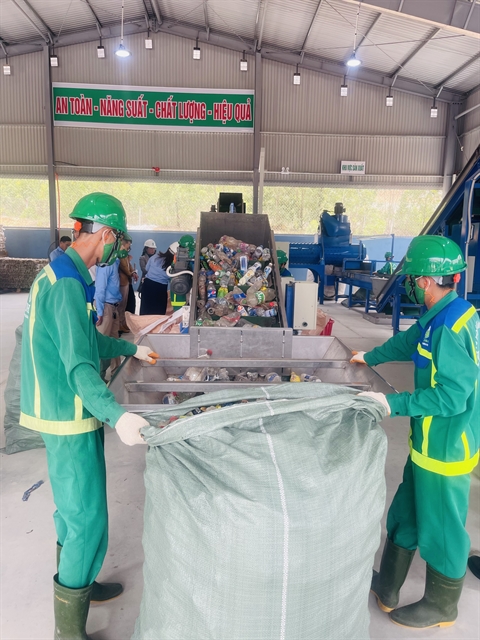 |
| Workers prepare to put plastic waste into a classification chain at the Material Recovery Facility in the Long Mỹ solid waste treatment area in Phước Mỹ Commune, Quy Nhơn City. — VNS Photo Thu Trang |
A Material Recovery Facility (MRF) located in the Long Mỹ solid waste treatment area in Quy Nhơn City's Phước Mỹ Commune has been recently inaugurated by the Bình Định Environment Joint Stock Company in cooperation with the UNDP.
It is designed to collect and separate plastic waste from domestic sources.
Construction on the MRF began on July 3 this year. The facility has an area of 1,000sq.m and an infrastructure investment cost of nearly VNĐ8 billion (US$323,596).
Operated by the Bình Định Environment Joint Stock Company, it will create jobs for 20 workers and more than 200 informal labourers participating in the plastic waste collection network.
The MRF will receive plastic waste from multiple sources, including the Quy Nhơn Fishing Port, collection points within Quy Nhơn City, restaurants, hotels and supermarkets, households, waste buyers and landfill.
In the Quy Nhơn Fishing Port area, plastic waste generated on fishing vessels is first collected in specifically designed net bags and transported to the warehouse at the fishing port by the collection team.
At the warehouse, the collection team separates plastic waste based on requests from the MRF by type, such as bottles, nylon bags and other types of packaging.
Afterwards, the sorted plastic waste will be transported to the MRF for further processing.
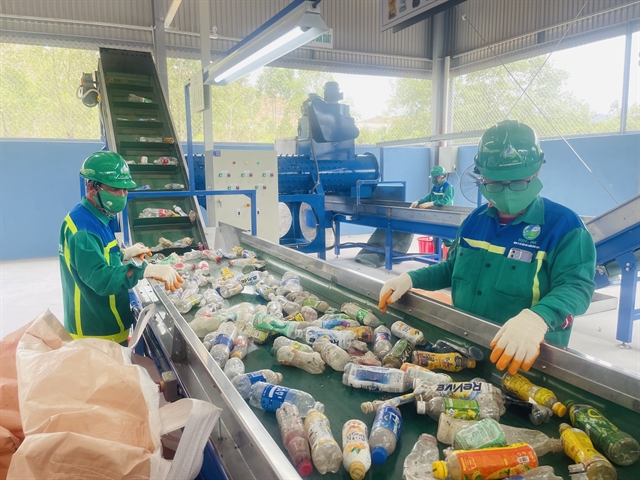 |
| Workers on duty to sort out plastic waste at a chain in the Material Recovery Facility. — VNS Photo Thu Trang |
Inside Quy Nhơn City, the project has established two collection points for gathering plastic waste, especially those coming from informal waste workers (IWWs) and households.
The collected plastic waste will then be brought to the MRF for further processing.
The MRF collection network also purchases plastic waste from restaurants, hotels and supermarkets either directly or indirectly through the IWWs, including waste buyers.
Households are also encouraged to separate waste at source to reduce the volume of solid waste generated.
The MRF actively engages in the purchase of plastic waste from waste buyers.
Plastic waste can be divided into different types there, which streamlines and facilitates the subsequent preliminary processing at the MRF.
Once collected and purchased, the plastic waste will undergo separation and processing at the MRF, according to the operation procedures.
The projected capacity of the MRF is from two to four tonnes per day.
After being sorted, plastic waste will undergo various treatment processes.
Bottles and nylon bags will be baled, while the other plastics will be ground, washed, dried and put into jumbo bags.
The MRF’s output, including baled and ground plastics, will be sold to recyclers, creating a closed loop for plastic waste and helping to reduce the use of virgin materials in value chains.
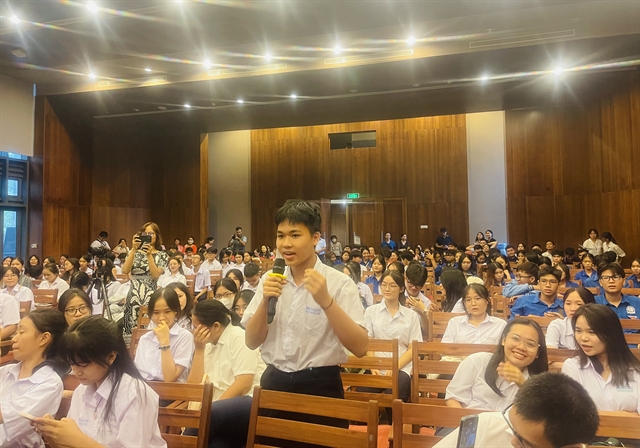 |
| A junior secondary student raises his opinion about waste reduction, reuse and recycle in a competition about the issue in Ghềnh Ráng Ward, Quy Nhơn City. — VNS Photo Thu Trang |
Nguyễn Tấn Nghĩa, Chairman of the Bình Định Environment Joint Stock Company’s Board of Directors, said that the MRF would support the collection, transportation, preliminary processing and recycling of plastic waste from its source, thus reducing the amount of plastic waste discharged into the environment.
“Economically, the MRF is designed to increase the efficiency of resource use, especially plastic raw materials for the plastics industry and plastic recycling industry, which are lacking domestic plastic materials,” said Nghĩa.
“Socially, the MRF will contribute to creating more green jobs for the locality, especially creating livelihoods for the informal labour force when participating in the network of collecting and providing input scrap," he said. — VNS
